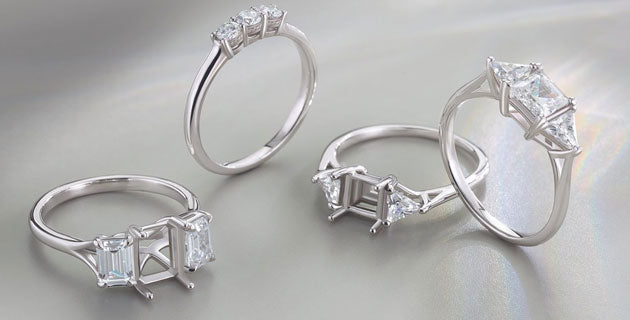
Lab-grown diamonds, also known as synthetic diamonds or cultivated diamonds, are diamonds that are created in a controlled laboratory environment, as opposed to natural diamonds which are formed in the earth over millions of years. The process of creating lab-grown diamonds involves replicating the high pressure, high temperature (HPHT) and chemical vapor deposition (CVD) conditions that occur in nature. The result is a diamond that is chemically, physically, and optically identical to a natural diamond.
Lab-grown diamonds are becoming increasingly popular as an alternative to natural diamonds due to their lower cost and the fact that they do not involve mining, which can have negative environmental and social impacts. They can also be produced in a variety of colors and sizes, which can be difficult to find in natural diamonds.
Lab-grown diamonds are graded and certified in the same way as natural diamonds, and they can be used in all types of jewelry, including engagement rings, wedding bands, and other fine jewelry items. They are also becoming increasingly popular in industrial applications, such as cutting and polishing tools, as well as in electronics and optics.
It is important to note that lab-grown diamonds are different from diamond simulants such as cubic zirconia, moissanite, or white sapphire, which are not made of pure carbon like diamonds and have different physical and optical properties.
Comparison chart between lab-grown diamonds and natural diamonds
Here is a comparison chart between lab-grown diamonds and natural diamonds:
|
Feature |
Lab-Grown Diamonds |
Natural Diamonds |
|
Origin |
Created in a laboratory |
Formed naturally in the earth |
|
Creation process |
High pressure, high temperature (HPHT) or chemical vapor deposition (CVD) |
Natural geological processes |
|
Cost |
Generally less expensive than natural diamonds |
Generally more expensive than lab-grown diamonds |
|
Availability |
Can be produced in a variety of colors and sizes |
Limited by natural availability |
|
Certification |
Graded and certified in the same way as natural diamonds |
Graded and certified in the same way as lab-grown diamonds |
|
Durability |
Same as natural diamonds |
Same as lab-grown diamonds |
|
Environmental impact |
No mining required |
Mining can have negative environmental impacts |
|
Physical properties |
Identical to natural diamonds |
Identical to lab-grown diamonds |
It is important to note that lab-grown diamonds are chemically, physically, and optically identical to natural diamonds, which makes them a suitable alternative for those who are looking for a diamond but want to avoid the negative environmental impact of diamond mining, or simply want a more affordable option. But it is also important to note that a natural diamond has a unique history and it's own story, which can be sentimental to some.
Benefits of Lab-Grown Diamonds
There are several benefits of lab-grown diamonds compared to natural diamonds, including:
Cost: Lab-grown diamonds are generally less expensive than natural diamonds, making them a more affordable option for consumers.
Availability: Lab-grown diamonds can be produced in a variety of colors and sizes, which can be difficult to find in natural diamonds.
Environmental impact: Lab-grown diamonds do not require mining, which can have negative environmental and social impacts.
Consistency: Lab-grown diamonds are created under controlled laboratory conditions, which results in a more consistent product compared to natural diamonds.
Traceability: Lab-grown diamonds have a clear chain of custody from the lab to the consumer, which allows for better traceability and transparency compared to natural diamonds.
Ethical: Lab-grown diamonds are considered more ethical than mined diamonds, as they do not involve exploitative labor practices or human rights violations that can occur in diamond mining.
Investment: Lab-grown diamonds are becoming an increasingly popular investment option as they are cheaper than natural diamonds, and the demand for lab-grown diamonds is increasing with the awareness of environmental and ethical issues.
Variety: Lab-grown diamonds can be produced in a range of colors and sizes, making them more versatile than natural diamonds.
Quality: Lab-grown diamonds are graded and certified in the same way as natural diamonds, so they have the same quality, durability, and physical properties as natural diamonds.
It is important to note that lab-grown diamonds are not for everyone, and some people prefer natural diamonds for sentimental reasons or for the unique history and story that each natural diamond has.
Selling tips for Lab-Grown Diamonds
Here are some tips for selling lab-grown diamonds:
Emphasize the benefits: Highlight the benefits of lab-grown diamonds such as their affordability, consistency, traceability, and environmental impact.
Compare to natural diamonds: Explain how lab-grown diamonds are chemically, physically, and optically identical to natural diamonds, and that they can be graded and certified in the same way as natural diamonds.
Use visuals: Use high-quality images and videos to showcase the beauty and quality of lab-grown diamonds.
Provide certifications: Provide certifications from reputable organizations that confirm the quality and authenticity of the lab-grown diamonds.
Offer different options: Offer a range of lab-grown diamond options, including different colors and sizes, to appeal to a wide range of customers.
Provide education: Provide educational resources to help customers understand the differences between lab-grown diamonds and natural diamonds, as well as the benefits of lab-grown diamonds.
Emphasize the ethical aspect: Highlight that lab-grown diamonds are ethically and environmentally responsible choice, as they do not involve exploitative labor practices or human rights violations that can occur in diamond mining.
Offer a Guarantee : Offer a money-back guarantee or a lifetime warranty to give customers peace of mind and build trust in your product.
Be transparent: Be transparent about the origin of the lab-grown diamonds, and how they were created.
Offer a variety of designs: Offer a variety of designs, styles, and settings to appeal to different tastes and preferences of customers.
Be prepared to answer questions: Be prepared to answer any questions customers may have about lab-grown diamonds, and be able to provide them with accurate and reliable information.


0 comments